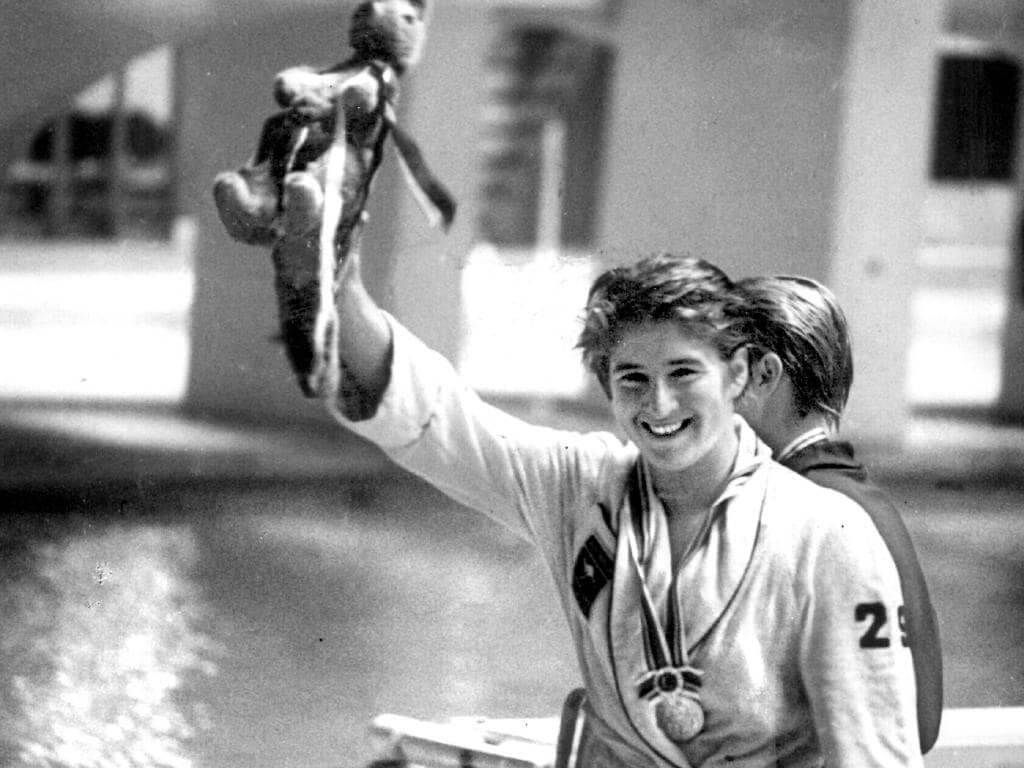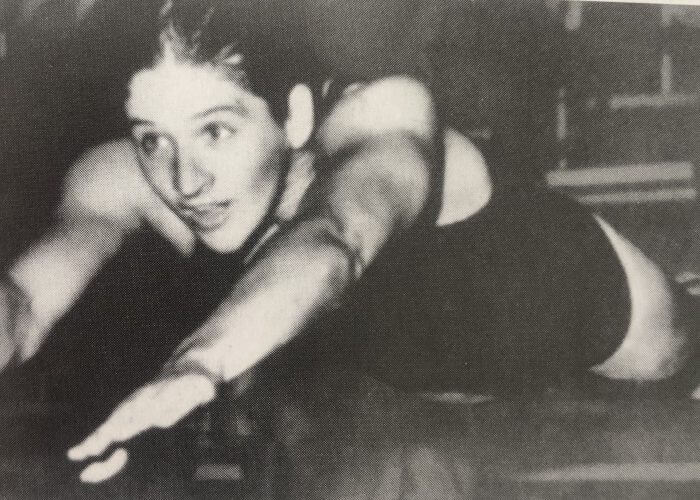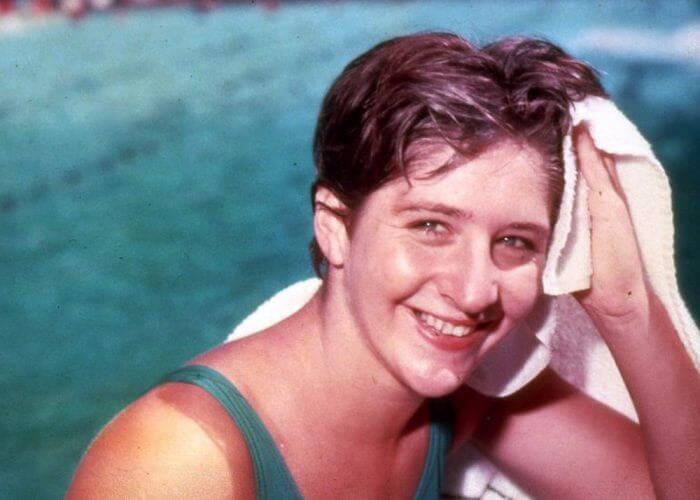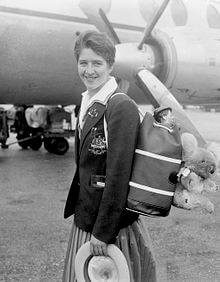Olympic Flashback: Dawn Fraser and the First Olympic Three-Peat

Olympic Flashback: Dawn Fraser and the First Olympic Three-Peat
On October 11, 1964, the Olympic Games in Tokyo opened. During the week in Japan, Australian star Dawn Fraser made history by capturing the 100-meter freestyle for the third consecutive time. The feat was the first of its kind in Olympic swimming.
Find an expert on the sport and ask that individual to identify the greatest male and female swimmers in history. The answer for the guys is usually instantaneous: Michael Phelps. Truthfully, any other answer reveals foolishness. Obtaining a majority among the gals is much more difficult. Tracy Caulkins and Janet Evans are in the conversation. Arguments are made for Krisztina Egerszegi. Despite her active status, Katie Ledecky has already achieved such greatness that votes are cast on her behalf.

Photo Courtesy: Dawn Fraser Collection.
The other contender for female GOAT status (Greatest of All Time) requires a trip back in time of more than a half-century. It also requires a trip Down Under. Back then, and there, is where Dawn Fraser is found. Hailing from a nation with a rich aquatic history, Fraser spent the middle part of the 1900s establishing herself as a freestyle legend.
There haven’t been many stretches over the past century-plus in which Australia has been a non-player on the international scene. But when Fraser came along in the early 1950s, there was a lull in the Aussie ranks. It was Fraser who lifted her nation back to prominence, first capturing back-to-back gold medals at the 1956 and 1960 Olympics. She then used the Games of 1964 as a stage for history, for it was that Olympiad in which Fraser became the first swimmer to win three consecutive titles in the same event, doing so in the 100 meter freestyle.
Just how challenging is an Olympic trifecta? Consider this fact: The club of three-peaters only features a quartet of members: Fraser, Egerszegi, Phelps and Ledecky.
Setting the Stage
Before celebrating Fraser’s historical achievement from Tokyo, there must first be a look at how she came to pursue the triple. It can be easily argued that her rise to stardom hinged on her crossing paths in 1950 with Harry Gallagher, the man who would coach Fraser to excellence. While talent is obviously the key ingredient for any global success, it must be nurtured and molded, and Gallagher had the perfect approach for working with Fraser.
 Fraser wasn’t the easiest of pupils with whom to work. She could be hard-headed and rebellious. She was brash. She could be defiant. Yet, Gallagher knew how to work with these traits, and devised a blueprint that took Fraser’s unquestioned skill set to the greatest heights.
Fraser wasn’t the easiest of pupils with whom to work. She could be hard-headed and rebellious. She was brash. She could be defiant. Yet, Gallagher knew how to work with these traits, and devised a blueprint that took Fraser’s unquestioned skill set to the greatest heights.
“Dawn was a horror,” Gallagher once said. “She told me I was a deadbeat, to drop dead, to piss off, to get lost. She wasn’t going to do what I wanted her to do. No guy would ever get her to do what she didn’t want to do. She had wild aggression. She reminded me of a wild mare in the hills that you had put the lightest lead on to keep her under control. She wanted to do her own thing. If you had to guide her, it had to be very subtly, so she didn’t understand that she was being manipulated. I used to say that, you know, ‘Dawn, no girl has ever done this before, and I don’t think you can do it either, but you just might be able to do it.’ She’d say, ‘What do you bloody mean? Of course I can bloody well do it.”
Gallagher’s psychological genius and Fraser’s talent proved to be a perfect combination. While Gallagher recognized how to work with his star athlete, Fraser understood the importance of Gallagher as a mentor, and a give-and-take relationship was established. At the 1956 Olympics in Melbourne, the partnership yielded the tandem’s finest moment to date. Behind a world-record performance, Fraser defeated compatriot Lorraine Crapp for gold in the 100 freestyle, simultaneously sparking her legendary status.
Following her Olympic breakthrough, Fraser etched herself as the globe’s premier female swimmer. She set multiple world records in the 100 and 200 free, and entered the 1960 Olympics in Rome as the heavy favorite to repeat in the 100, considered the sport’s blue-ribbon event. Indeed, Fraser prevailed in dominant fashion, as the Aussie bettered American Chris von Saltza by more than a second, an eternity in a two-lap event.
History for the Legend
Had Fraser opted for retirement following the 1960 Games, she would have walked away as an icon. It was rare during that era for swimmers to hang around for multiple Olympiads, let alone three. But Fraser has always been known for bucking the system and prolonging her career, and time on top only added to her legacy.

Photo Courtesy: Delly Carr (Swim Australia/Ascta)
As the 1964 Olympics in Tokyo beckoned, Fraser continued to flourish. Additional world records fell, and in 1962, she became the first woman to crack the one-minute barrier in the 100 freestyle. For all she had previously achieved, Fraser was getting better and was seemingly headed to her third Olympiad as an undeniable force. Of course, not all plans unfold smoothly.
Seven months before the Tokyo Games, Fraser endured a physically and emotionally crippling life event. Leaving a fund-raiser, Fraser was the driver of a car that also carried her mother, sister and a friend. During the ride home in the early-morning hours of March 9, 1964, Fraser was forced to veer out of the way when her car suddenly came upon a truck. When Fraser swerved, her car flipped over, leading to disastrous results. While Fraser, her sister and friend were injured, Fraser’s mother was killed, pronounced dead upon arrival at the hospital. Fraser’s brother initially informed her that their mother died of a heart attack prior to the crash, but as Fraser prepared to write her autobiography, she learned that her mother’s death was actually the result of injuries suffered in the car accident.
“I was led to believe by my family for many, many years, that my mother had died prior to the accident,” Fraser wrote in her autobiography. “I did not feel good inside, but I know I’ve wiped away that question mark in my mind. Over the years, I’ve realized you can beat yourself up at night, lose sleep…but you can’t change the past. My parents taught me to accept things the way they were, the rights and the wrongs…and to learn from my mistakes.”
With the car accident so close to the Olympics in Tokyo, questions rightfully arose concerning Fraser’s ability to three-peat. Really, Fraser would have been excused had she bypassed a third Olympics. Not only was she carrying the enormous weight of her mother’s death, but the crash also left Fraser with a chipped vertebra that forced her to wear a neck brace for nine weeks. More, doctors advised her not to dive off starting blocks due to the risk of furthering her neck injury. It wasn’t until the Olympics in which Fraser dove off the blocks with full force.
As Fraser prepared to chase a third straight gold medal in the 100 free, she wasn’t simply battling her own physical and mental demons. American Sharon Stouder had emerged as a prime challenger, and Fraser would have to produce one of the best efforts of her career to retain her crown. Ultimately, that is what the Aussie managed, as she came through in the final to clock an Olympic record of 59.5, ahead of the 59.9 produced by Stouder.
In less than a minute of race time—but with years of work and dedication providing fuel—Fraser had become the first swimmer to win the same event at three consecutive Olympiads. It was truly a remarkable feat, a triumph well ahead of its time. Years down the line, Egerszegi joined Fraser in the special club, winning the 200 backstroke at the 1988, 1992 and 1996 Games. Eventually, Phelps was given his key, too, and went a step further by winning the 200 individual medley at four consecutive Games (2004-16). Last summer, Ledecky pulled off the feat. But Fraser will forever be the president emeritus of the Three-Peat Club.
It is worth noting that America’s first sprint star, Duke Kahanamoku, could have beaten Fraser to the treble. Kahanamoku was the Olympic champion in the 100 free in 1912 and 1920, but had his 1916 Olympic opportunity stolen by the cancellation of the Games due to World War I.
“I put myself under a lot of pressure by deciding to go to Tokyo, and I also put myself under a lot of pressure to compete in the same event in three Olympics,” Fraser said. “I had, at the back of my mind, that this was for my mother because we were saving up for my mother to go to Tokyo with me. I just imagined that she was there and that I was doing it for her.”
An Extra Souvenir
If Fraser’s excellence in the pool cemented her identity as an all-time great, her third gold medal in the 100 free apparently wasn’t enough of a souvenir from her visit to Tokyo. After completing her work in the pool, the rebellious Fraser set out on a night excursion with Howard Toyne, an Australian Olympic team doctor, and Des Piper, a member of Australia’s field hockey team. The trio planned on obtaining some Olympic flags that lined the street leading to the Imperial Palace, the main residence of the Emperor of Japan.

Dawn Fraser’s three-peat in the 100 freestyle remains an iconic achievement in the sport.
After getting two flags in their possession, police were alerted, and Fraser and her countrymen were arrested, taken to the police station and threatened with jail time. However, Fraser’s prominence was soon revealed, and all three Aussies were released, the lieutenant of the police station actually allowing Fraser to keep one of the stolen flags.
“After showing them my gold medal and my dog tags, (the police) were still very disgusted that I’d…that it was me…that I would do that,” Fraser said. “They explained to me that it was a stealing offense, and it could mean a jail term. But they decided then because of who I was, Dawn Fraser, they let us off.”
The Tokyo police may have been lenient with Fraser, but Australian Swimming was tired of its Glory Girl and her antics. The organization saw the flag incident as a third strike against Fraser. Prior to the flag shenanigans, Fraser—against team orders—walked in the Opening Ceremony in Tokyo, rather than rest. She also donned a suit for competition that she felt was more comfortable, but was not the team-sponsored suit. The accumulated offenses led Australian Swimming to institute a 10-year ban against Fraser, a decision that led to her retirement.
Although the ban was lifted prior to the 1968 Olympic Games in Mexico City, Fraser didn’t feel like she had the appropriate amount of time to come out of retirement and prepare for a pursuit of a fourth consecutive title in the 100 free. It was the end.
Ahead of Her Time
When the Olympic Games return to Tokyo next summer, only Ledecky has the chance to become the fourth member of the illustrious Three-Peat Club. Ledecky has the opportunity to triple in the 800 freestyle, and the fact that she is the lone individual who can three-peat—particularly in this era of lengthened careers—speaks to the difficulty of the challenge.
Considering Fraser achieved the feat at a time when careers were primarily one-Olympics-and-done only emphasizes that she was ahead of her time and set a spectacularly high bar to chase. Although it will never be known, one also must wonder if Fraser—a multi-time world record holder in the event—could have also managed the accomplishment in the 200 freestyle, which did not become an Olympic event for women until 1968.
Memorable moments are sure to develop at the 2020(2021) Games, and as these new memories are celebrated, what Dawn Fraser achieved in Tokyo 57 years earlier is sure to be celebrated, too. History never disappears. Instead, it serves as a reminder of the past and the greatness that came before and should never be forgotten. For Fraser, she will always be the first swimmer to win Olympic gold in the same event at three consecutive Games, each victory defined in its own way, but the last defining history.
“I can remember precisely what I said,” Fraser stated about the completion of her triple. “I said to myself, ‘Thank God that’s over!’”




Happy Olympics Day!
She probably would’ve won the 100 free again if the IOC hadn’t banned her.
No goggles, no fancy suits, no support team of physios and sport psychologists, no funding, no sponsorship… she did it all whilst working to support herself….
To my generation Dawn Fraser was an idol. I had the privilege of swimming in two international events in 1962 and 1964 and Dawn Fraser was a role model for every female swimmer. Dawn always took the time to speak to many younger swimmers from all over the world and was a true champion in and out of the pool. If she competed in the 1968 Olympics I am sure she would have won.
Wow 10 year ban seems rather excessive doesn’t it ? That’s sun yang-esque levels